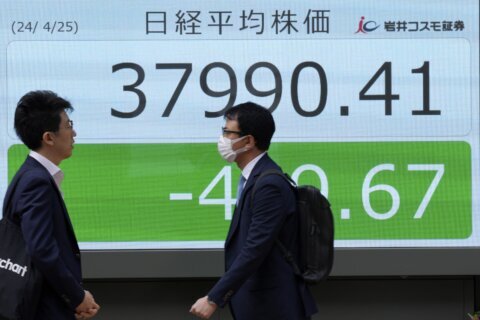CANBERRA, Australia (AP) — Australia’s government presented a range of economic measures on Tuesday such as halving the tax on gasoline to help cushion the impact of high inflation and win votes at elections due by May.
Inflation fueled by the Ukraine war, the pandemic’s disruption to supply chains and widespread flooding disasters across central and eastern Australia is expected to reach 4.5% in the current fiscal year which ends on June 30, according to Treasury Department documents.
Treasurer Josh Frydenberg on Tuesday outlined his economic blueprint for the next fiscal year with an eye to elections that must be held by May 21.
The measures included one-off 250 Australian dollar ($187) so-called Cost of Living Payments, tax offsets for millions of low and middle income earners, and a reduction in the gasoline tax.
With inflation increasing in Australia and elsewhere driven in part by higher oil prices, the tax on gasoline and diesel will be halved from 44 Australian cents (33 cents) a liter ($1.25 a gallon) for six months from Wednesday at a cost to the government of 3 billion Australian dollars ($2.2 billion).
The Australian Institute for Petroleum said the national gasoline price average fell 5.8 Australian cents (4.3 cents) last week to 2.07 Australian dollars ($1.54) per liter ($5.86 per gallon).
Frydenberg said inflation was forecast to fall to 3.5% next fiscal year and to 2.5% in 2023-24. Australia’s central bank aims to keep inflation within a 2-to-3% band.
But he conceded times were uncertain with Russia’s invasion of Ukraine continuing and the pandemic potentially dragging on China’s economy.
“Risks to the outlook remain, including the pandemic, but Australia is well placed to manage those risks,” Frydenberg said.
Australia’s inflation rate remains less than half that of the United States and well below those of Canada, the European Union and Britain.
Prime Minister Scott Morrison is set to announce as early as next week an election date. His conservative coalition is seeking a rare fourth three-year term and is trailing the center-left Labor Party opposition in most opinion polls.
Opposition treasury spokesman Jim Chalmers said the government’s plan did not address the underlying problem of wages growing slower than inflation.
“All the government’s done here is take a whole bunch of economic challenges before the election and push them to the other side of the election,” Chalmers told Australian Broadcasting Corp.
“So it’s very shortsighted, very desperate, very panicked and I think the country deserves much better,” he added.
Better than expected prices for commodities including iron ore and coal had led to a smaller deficit for the current fiscal year than the 99.2 billion Australian dollars ($74.3 billion) forecast by the government in December.
The debt predictions were based on what Frydenberg described as conservative forecasts for prices of Australia’s most lucrative exports: iron ore and coal.
Metallurgical coal used in steelmaking was expected to fall from $512 to $130 a metric ton next year. Iron ore was forecast to fall from $134 to $55 a metric ton. But the iron ore price is buoyant and reached $152 on Tuesday.
“If these high prices stay in place for the next six months as they are, that would be worth an additional 30 billion Australian dollars ($22 billion) to the budget bottom line,” Frydenberg said. “The world is very uncertain at the moment.”
Treasury documents warn that a steep slowdown of the Chinese economy, perhaps due to a widespread COVID-19 outbreak, could push commodity prices lower than the government’s assumptions.
Australia’s gross debt as a share of the economy is forecast to peak in mid 2025 at 44.9%, or 1.117 trillion Australian dollars ($836.8 billion). That peak would come four years earlier and 5.4 percentage points lower than predicted in December.
Net debt — gross debt less the value of selected financial assets — would peak at 33.1% of GDP, or 864.7 billion Australian dollars ($647.8 billion), a year later.
GDP was expected to grow 4.25% this fiscal year before falling to 3.5% next year and 2.5% in 2023-24.
Unemployment in Australia fell to 4% in February for the first time in 14 years. The jobless rate is forecast to reach 3.75% in September for the first time since 1974, further reducing the government’s welfare costs.
Defense spending will exceed 2% of GDP in the current fiscal year. The government plans to spend 575 billion Australian dollars ($431 billion) on defense in the decade through 2029-30.
The United States, Britain and Australia announced in September a new security partnership that would provide to Australia a fleet of submarines powered by U.S. nuclear technology.
Australia has yet to settle on a design and the costs of buying the submarines have not been detailed in the budget forecasts for the next four years.
Apart from submarines, the government announced it was cooperating with the United States and Britain under the same so-called AUKUS partnership to enhance Australia’s offensive and defensive cyber and intelligence capabilities.
The government plans to spend 9.9 billion Australian dollars ($7.4 billion) over a decade on the technology that would double the size of the Australian Signals Directorate, a security agency, creating 1,900 new jobs.
Copyright © 2024 The Associated Press. All rights reserved. This material may not be published, broadcast, written or redistributed.






